Every Hearthstone expansion has its own gimmick – new keywords or mechanics that make it stand out. We can see it as far as Goblins vs Gnomes and Mechs, or The Grand Tournament and Inspire cards. More recently, Knights of the Frozen Throne had Hero cards, Kobolds & Catacombs had Legendary weapons, and The Witchwood has Odd/Even decks. This time around, however, I’ll take a closer look at one of the most unique mechanics Hearthstone ever had – Quest cards from Journey to Un’Goro.
The idea behind them is relatively simple, yet interesting. You’re playing a role of the adventurer, on a journey through the Un’Goro crater. You get the Quest card in your opening hand every time. After you play it, you need to finish a certain task in order to get your reward. Without a doubt, all of the rewards are very powerful – but are they powerful enough to justify the sometimes difficult requirement, the fact that you need to build the deck around them, not to mention sacrificing one card in your starting hand? Well, let’s find out.
I will look at each of the nine Quests introduced in Journey to Un’Goro and talk a bit about their history. How did they work out when they were first released, did they see any more play during the last year, and how do they look right now, then briefly discuss whether Quest mechanic is something that we might see again in the future.
Druid – Jungle Giants
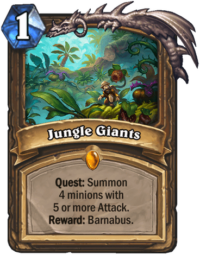
Jungle Giants has never made it to the mainstream meta, but it was always a card liked by off-meta players, because it offers so many possibilities. Making every minion in your deck free has many different applications.
At first, it was mostly played in so-called “Big” decks, which are basically Druid builds with lots of ramp and high cost minions. If you manage to get two, three or even more points of mana ahead of your opponent, you will be able to drop big threats sooner than you should, and either build a defensive wall (vs Aggro) or put pressure (vs Control). If you run 10 or more high cost minions, then the perspective of being able to play them for 0 mana after you finish the Quest sounds great. However, the decks never really took off for one simple reason – ramp is still more important. By the time you finish the Quest, it’s late game already, and while being able to play 2-3 big minions in a single turn is great, it’s even more important to draw your ramp, and starting with one less card drastically decreases your chance to get a key Turn 2 Wild Growth.
Two cards in particular have made Quest Druid stronger – Ultimate Infestation from Knights of the Frozen Throne (not only the 5/5 minion triggers the Quest, but it’s a massive Quest draw for after you finished the Quest already) and Cursed Disciple (plus Oaken Summons to pull it more consistently, two triggers in one card). With those cards, Quest Druid was actually a pretty viable deck choice.
And so, after the failed Big Quest Druid experiments, Jungle Giants was used to make all kinds of Combo decks viable. Just think about it – how much better would a combo deck be if you could play a vital piece for 0 mana? And so, Malygos Druid was the most likely destination Quest Druid players would take. Of course, since Barnabus does not discount cards in your hand, drawing Malygos was sometimes a problem, but realistically you needed to draw Malygos, Ixlid, Fungal Lord and both Faceless Manipulators to be in a really bad spot. Alternatively, some Quest Druid players preferred the Charged Devilsaur + Carnivorous Cube version, but either way, Quest Druid has definitely peaked in Kobolds & Catacombs both in terms of popularity and viability.
Lately, due to some mechanic changes, the card was nerfed. Before, using Faceless Manipulator on a 5+ Attack minion gave you a Quest trigger, now it doesn’t. Since curving out with Disciple into Faceless was often the easiest way to finish the Quest, it’s pretty disappointing. All in all, different versions of Quest Druid were mostly off-meta decks since Un’Goro, but I’d say that it was a pretty successful card overall.
Hunter – The Marsh Queen
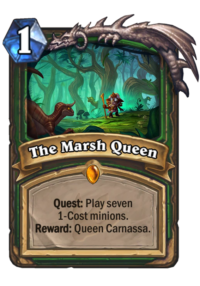
Probably the most discussed Quest before the Un’Goro’s launch, it got famous when Lifecoach said that this card is a terrible design and it might get broken. To be fair, he said that it will either be trash or be broken, or something along those lines, but it still became a sort of meme. It’s really hard to judge the card’s strength before it’s released, and this is a great example. It’s a card that looks good on paper, but when you actually start thinking about it, it doesn’t make much sense to play it.
Quest Hunter has some underlying issues that are hard to address. You need to play a lot of 1-drops in the deck, and the number of powerful 1-drops are limited. Since you play so many 1-drops, your deck leans towards Aggro, and yet you need to skip your Turn 1 every single time, not to mention that if you don’t draw well you might run out of steam just before you finish your Quest, having one or two awkward turns when you’re hoping to draw your last 1-drop to finish the Quest. Then, there is no guarantee that you will draw Carnassa's Brood – by the time you finish the Quest they make up for less than half of your deck – sometimes you won’t see one until 2-3 turns later. And even if you do, you still run a deck full of 1-drops, and while flooding the board with 3/2’s is nice, most Control decks can actually answer that in the late game – as an aggressive deck you don’t want to needlessly prolong the game, but you just have to do it with Quest Hunter.
Even though some support cards were released throughout the card’s existence (just looking at The Witchwood’s Ravencaller and Toxmonger) and multiple players have tried to make it work, Quest Hunter was never a viable deck. It can be played for fun, and you will definitely snatch some wins here and there, but don’t expect too much from it.
Mage – Open the Waygate
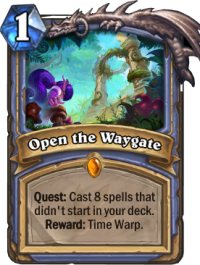
Probably the second most controversial Quest (after Rogue’s), Open the Waygate was also one of the most played Quests all the way through Year of the Mammoth. It was used in Exodia Mage, an OTK deck (well, technically TTK) that took its name from Yu-Gi-Oh’s Exodia (to make a long story short, after you draw each of the five pieces of Exodia, you can just declare victory), since it shares some similarities. It’s a 5 cards combo that lets you generate infinite Fireballs.
Exodia Mage was a pretty prominent deck all the way from Un’Goro to Kobolds & Catacombs. The basic idea behind the deck was to stall the game for as long as possible, while cycling through the deck. After finding all of the combo pieces and finishing the Quest, you could drop 2x Sorcerer's Apprentice + Molten Reflection, then finish your Quest, then drop Archmage Antonidas, play the final Molten Reflection and have 0 mana Fireball, which cycles into another Fireball once you play it. While it was technically possible to stop the combo with absurd amounts of Armor, you needed as much ~200 Armor to really stop it (of course, it depends on the Mage’s APM, but it was mostly unattainable in a normal game).
The deck got a nice boost in Knights of the Frozen Throne, when Simulacrum was released. One of the common problems of Exodia Mage was one piece of the combo stuck on the bottom of your deck, or your opponent using Dirty Rat to remove it from your hand. Simulacrum added some consistency. Still, even at its peak, the deck wasn’t high tier – while it had some nearly auto-win matchups (against those slow, grindy decks that didn’t put enough pressure), it also lost to aggressive builds. It was a very common counter-pick, especially in the tournament scenarios, where line-ups were much more streamlined and predictable.
A less popular version of the deck used Giants and Alexstrasza instead of the combo, however, that version was easier to counter. Others, like Savjz, were also playing Highlander Quest Mage, but it was hard to call that deck truly viable.
However, the latest rotation has basically killed the deck. I’ve seen people tried different versions of Quest Mage, but they just don’t work. The deck took too many losses. Not only it’s harder to finish the Quest (Babbling Book and more importantly Cabalist's Tome are gone), but the deck has lost Ice Block, which gave it crazy amounts of extra survivability, as well as Coldlight Oracle, which was a great cycle tool. It might still come back thanks to the cards released in the upcoming two expansions (taking extra turn is a powerful reward after all), but for now, if you want to play it, you need to switch to the Wild format.
Paladin – The Last Kaleidosaur
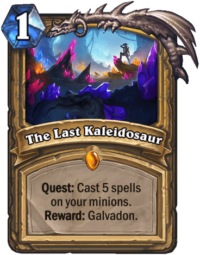
Oh the Paladin’s Quest. Most of you probably forgot that this card exists, unless you’re a fan of a certain handsome streamer (yes, I’m looking at you, Kibler) – he won’t let you forget that it does indeed exist. Especially after you hear Natalie’s singing the Galvadon theme, oh boy, you will want to play the deck yourself!
However, if you are not Kibler, you might think twice before crafting The Last Kaleidosaur. Quest Paladin is, how can I put it, not the best deck you’ve ever seen. It’s probably not even in the top 50, and there are a few reasons for that.
First of all – the Quest is pretty difficult to finish. Casting 6 spells on your minions, preferably buffs (technically you can also trigger it with Hammer of Wrath, but that’s not really something you want to do), means that you need to be playing LOTS of those in your deck in the first place. But buffs aren’t that great. Sure, you have some nice ones, like Blessing of Kings or Spikeridged Steed, but those two alone are not enough to finish the Quest. And if you put so many buffs into your deck, the rest of it is going to be a bit awkward. You run into situations in which you end up with buffs in your hand but nothing to put them on. Yeah, sure, you can Hero Power and buff, but playing let’s say a 6 mana 5/5 that can be Silenced down to 1 is not amazing.
While the reward itself is nice – 5 mana 5/5 that Adapts FIVE times – it’s just that the rest of your deck is not that great. You basically have to rely on Galvadon to win you the game. And it would be great if it did – but the problem is that it’s not very consistent. Since there are 10 different adapts and they’re random, there is a chance you won’t get the ones you need. Ideally, you want to get Stealth, Windfury and then as much attack as possible or maybe a Divine Shield to protect it against some AoEs (depends on the matchup). However, not getting Stealth means that it can get removed quite easily (you can pick “Can’t be targeted”, but that’s slightly counter-productive, since you won’t be able to buff it either). If you don’t end up getting Windfury, it won’t likely be enough to finish the game. Not to mention that all sorts of Taunts can block it, some AoEs can also straight up kill it (such as Brawl) or at least stall it (Psychic Scream, Blizzard).
To be fair, the deck has gotten a nice boost in The Witchwood, thanks to the Sound the Bells!. Since it has Echo, you can e.g. use it on Turn 6 to get three Quest triggers. Overall, it reduces the number of buffs necessary in your deck. But at the same time, it creates another problem – you need to put more cycling into your deck, because if you don’t draw it, then you won’t be able to finish the Quest. Right now it’s probably closest to being viable it ever was, and two upcoming expansions might tip the scales.
Still, if you still want to try it out, tune into the Galvadon’s theme and go craft the Quest! The deck is pretty fun, even if your win rate won’t be very high.
Priest – Awaken the Makers
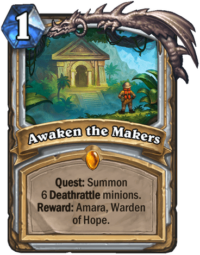
Awaken the Makers was the first Quest revealed, and one of the more hyped ones. Assuming that you build a Deathrattle Priest, which isn’t actually that bad, you can finish it quite easily. And when you finish it, you get a 5 mana 8/8 Taunt that heals you up to not even 30, but 40. It’s like a better Reno Jackson. Well, except the fact that you could put Reno into any single deck (assuming you met the condition of no duplicates), and it’s not that easy with Awaken the Makers.
Many players have tried to make it work, and while it briefly looked like it might be a viable deck early in Un’Goro, it turned out that it just wasn’t. It’s not like finishing the Quest was difficult – but it was still too slow vs Aggro (most of the time the game was over before you could finish the Quest) and it didn’t really matter vs Control, unless you played against some deck with a burn finisher. The Quest was mostly forgotten, until Savjz started experimenting with it in Kobolds & Catacombs. He built this weird deck, in which Weasel Tunneler – basically a meme card – was a central point of the list. And so, Weasel Priest was created. The build played all kinds of ways to get more Weasel Tunnelers on the board and survive for as long as possible. The goal was to shuffle so many Weasel Tunnelers into your opponent’s deck that he ended up drawing nothing but them. And at that point, when your opponent draws 1/1 minions every turn, you had an easy win. The deck was never really a part of the meta, it became quite popular on the ladder briefly, but it quickly disappeared. Still, it was a fun deck played by many streamers, sometimes even in high Legend. Surprise factor played a big role, as the deck’s win rate went down heavily after everyone knew what’s going on already.
The latest rotation made the deck unplayable in Standard, because it was – obviously – missing the most important card, which is Weasel Tunneler. But it doesn’t mean that The Witchwood was the end of Quest Priest. On the contrary, this expansion marks the first time Quest Priest became a viable meta deck… at least for a while. After the latest nerf patch, for a week or so, Quest Priest was one of the most popular lists on the ladder. Instead of going for some gimmick, it just went for a slow, Control, even fatigue approach – running Archbishop Benedictus as its fatigue win condition. That was mostly because the meta has slowed down and people didn’t really run a lot of the decks that could disrupt this deck’s game plan. While it’s no longer the case, and meta does not favor Quest Priest heavily, it’s still a deck you can actually meet on the ladder from time to time. According to the latest Vicious Syndicate Data Reaper Report’s, Quest Priest makes up for a roughly 1.5% of the decks up to Rank 15, which is not that bad.
Overall, until the Kobolds & Catacombs, the Quest Priest builds were nearly non-existent, and it’s an off-meta build for the last 6 months or so. However, in the end, it’s a pretty solid Quest that can work pretty well in the right meta. I suspect that it’s not the last time we hear about the Quest/Deathrattle Priest this expansion.
Rogue – The Caverns Below
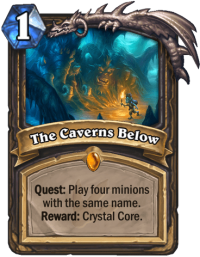
When talking about Mage’s Quest, I’ve called it the second most controversial (despite having a low win rate, a lot of people called for a nerf, because it was not fun to play against) Quest, and here’s the one that would take the top spot. The Caverns Below. One of the only cards in Hearthstone that has been nerfed twice (even including the Alpha/Beta nerfs). Both of the nerfs were pretty significant, and funnily enough, some people are still having success with the deck. It’s no longer a meta deck, but it had two brief periods of being a very common meta choice – both of which were followed with a change.
Before Journey to Un’Goro was released, the Quest was undervalued by most of the players, including me, as something pretty difficult to finish and not consistent. However, people didn’t take the fact that if you literally build an entire deck around finishing it as quickly as possible, you end up with a bunch of cheap 5/5’s with many different effects. When the Un’Goro launched, and Dog hit #1 Legend with this Quest very early (it was Day 1 or Day 2 of the expansion), the deck has flooded the ladder. And the playerbase was divided. People who played Aggro were happy with that, because they got a lot of free wins. The deck just wasn’t capable of consistently fighting the Aggro off, and by the time you finished the Quest, you were often dead or very close to dying. On the other hand, Quest Rogue was a bane of Control and Combo decks. Since those had no way to put pressure early, and Rogue could just play their game and finish the Quest quickly, some slow matchups were a walk in the park for Valeera. Just putting two or three 5/5 minions on the board every turn meant that a Control deck ran out of removals quickly, not to mention the crazy amounts of burst damage Quest Rogue could pull off thanks to the Charge minions and bounces. And so, the Quest was nerfed (the number of minions needed to finish it was upped from 4 to 5), and everyone forgot about it… for a while.
Numerous players attempted to revive it throughout the last Standard year, but without any major successes. I think that Gyong hit high Legend ranks with it a few times, but mostly in a still developing meta after some expansions or nerf patches. It took the deck another year to finally come back in The Witchwood. What changed? Mostly the meta. Quest Rogue is a very meta-oriented deck. It’s not just “okay against everything”, it has some clearly good and clearly bad matchups. If the bad matchups were dominating the meta, it made no sense to play it. The Witchwood meta, on the other hand, was generally slower and more friendly for this Quest. Release of the Vicious Scalehide also made the deck a bit better, as it was easier to come back after finishing the Quest when you were low. On the other hand, Gadgetzan Ferryman has rotated out, and that was a big loss, so I honestly mostly attribute it to the meta.
The reign of Quest Rogue didn’t last too long, though, as it was once again nerfed roughly 1.5 months into The Witchwood (and a month ago). Right now, the deck not only needs 5 instead of 4 minions to finish the Quest, but the global stats from the reward were changed from 5/5 to 4/4. It’s a big deal, the deck is so much weaker, but some players are still trying. For example, Triton has recently hit #23 Legend with Quest Rogue. It’s an off-meta deck now, but it’s still not completely dead.
The Caverns Below is without a doubt one of the strongest Quest cards from Un’Goro. Maybe even THE strongest, given that it needed to be nerfed twice to finally bring it down. Given that it was just nerfed, I wouldn’t recommend crafting it now, and I would be really surprised if we see it getting back in the mainstream again, but who knows? It has already surprised me twice.
Shaman – Unite the Murlocs
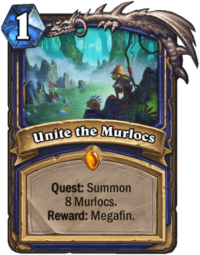
Shaman and Murlocs have this weird history. On one hand, Blizzard is dropping some Murlocs or Murloc synergy cards in Shaman from time to time. Starting with the Siltfin Spiritwalker (I never get his name right on the first try) all the way back from Goblins vs Gnomes, through Everyfin is Awesome from League of Explorers, to the more recent Brrrloc, Ice Fishing or Ghost Light Angler. And of course, Unite the Murlocs.
On the other hand, those cards are dropped so rarely that it’s not even possible to build an actual, viable Murloc Shaman deck. By the time the class gets enough synergies to maybe build something, the old ones are rotating out. Some thought that Unite the Murlocs is going to change that. Playing 10 Murlocs is a very difficult task, but there was a card that has made it much easier – Call in the Finishers. Just one spell added +4 to the Quest’s progress, and that was big. At the same time, there was a very clear problem with that approach – not drawing the Finishers meant that it took you SO LONG to finish the Quest. Primalfin Totem was also great if it could stick onto the board, but it rarely survived for more than a turn or two. Sadly for Shaman (or Murloc) fans, Everyfin is Awesome has rotated at the same time this Quest was printed, so you couldn’t go for 0-2 mana +2/+2 buffs on your whole board while playing the Quest.
The reward is also pretty solid. What Aggro decks need in the mid game is either way to close out the game or a massive refill. Megafin is like a Divine Favor on steroids – you get a 5 mana 8/8 Murloc, which is already big, and a hand full of random Murlocs on top of that. It’s awesome and can really win some games.
So why doesn’t it work? There are a few underlying issues with the Shaman’s Quest. First of all – Murloc Shaman is not good. No matter how you look at it, the deck is just mediocre. And if the deck is mediocre, building a Quest around it might not be the best idea. Second thing is skipping Turn 1. If you want to play the Quest on T1, you can’t play a Turn 1 Murloc. If you can’t play a Turn 1 Murloc, your Turn 2, 3, 4 etc. will be much weaker. E.g. you will have to play a Rockpool Hunter with nothing to buff. Skipping Turn 1 EVERY SINGLE GAME in Aggro deck is just bad. You often have to skip the Quest, actually, but this approach means that you’re stuck with it in your hand for even longer, delaying the pay-off. Also, Aggro deck starting with one less card is a big issue – not only it means that you have a weaker mulligan (and you need your early drops), but you also run out of cards more quickly.
The deck was somewhat playable in the last Standard year (pretty weak, off-meta deck, but still), but it is now really bad since Call in the Finishers has rotated out and trust me, summoning 10 Murlocs is not an easy task without that card (Ghost Light Angler helps a bit, but it’s still only 3 triggers on Turn 6). By the time you finish the Quest, you will most likely run out of steam and fall behind on the board so much that even Megafin won’t save you. All in all, Unite the Murlocs was not a very successful Quest.
Warlock – Lakkari Sacrifice
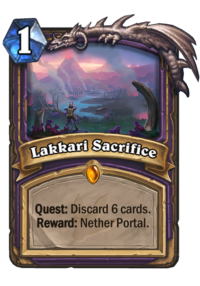
I was so hyped for this Quest before the Un’Goro’s launch. For some reason, I just love playing cards that give you infinite resources, and this is one of them. It’s one of those decks that I tried hard to make work, and failed in the end.
Discard Warlock was a thing for a long time. Ever since Karazhan, it was the most popular Zoo Warlock build. So the obvious reaction was that the deck got much stronger, since it got a Quest to play. But it wasn’t that easy. Players have quickly realized that this Quest just doesn’t fit into Zoo Warlock. It had similar issues to the ones I’ve described above, for Unite the Murlocs. Aggressive, board-oriented deck does not want to skip Turn 1 and start with one card less. Not to mention that in case of Zoo, the pay-off just came too late – by the time you finished the Quest, the game was often decided. So players tried different approaches.
But they have once again realized something. Discarding 6 cards is not an easy task. In the perfect case scenario, when you could discard Clutchmother Zavas and Silverware Golems, it wasn’t that hard. But in most of the games, you got rid of your normal cards that didn’t have any extra effects on discarding. So after just 2-3 discard, you often had no more resources in your hand, and you had to slow down and start tapping. Malchezaar's Imp saved the situation sometimes, but it usually died right after you played it, so it was mostly Imp + Discard card on the same turn, and on the next turn it was already gone. Discard cards discarding other discard cards was also a serious problem. It was just too slow, too clunky and didn’t work. You had to sacrifice so many tempo by tapping every turn, since you were discarding you hand, and the Quest didn’t let you come back fast enough to off-set that.
And so came Knights of the Frozen Throne, and players tried Discard Warlock again. Howlfiend was released, and it was another way to approach everything. Instead of running lots of discard cards, you could run only the best ones and Felhound, which would do the job most of the time. But it came with another problem – your opponent controlled how many cards you discard most of the time. Not to mention that playing him when you were close to finishing the Quest was really risky. For example, your opponent could hit him 2 times, finish your Quest, then hit him again to discard the reward, which was an absolute disaster. And so, the Quest didn’t work again.
Finally came Kobolds & Catacombs and another hope for Quest Warlock – Cataclysm. Since the card discarded your entire hand, as well as destroyed an entire board, you could actually make some interesting shenanigans. You just needed Cataclysm and 6 other cards in your hand to finish it. Even better, it actually cleared the entire board, so it was a good set-up for the Quest. In the perfect case scenario, you could even play Turn 4 Cataclysm into Turn 5 Quest. But once again it didn’t work. This time because of the consistency issues – not drawing Cataclysm was bad. Then if you built a slightly slower deck, you often had cards that you didn’t want to discard, and you couldn’t choose. On top of that, everything was still very clunky, and the Quest reward was just too slow, not fast enough to come back from your completely empty hand. The only solid combo was Malchezaar's Imp + Cataclysm on Turn 5, which discarded your entire hand and drew it again, but that didn’t come up very often.
Players have tried to play Quest Warlock for three expansions in a row, and it just didn’t work. Maybe its time is yet to come, but it’s hard to imagine that now, after Malchezaar's Imp and Silverware Golem are gone from Standard, it will suddenly start working. Overall, this quest was a huge flop.
Warrior – Fire Plume’s Heart
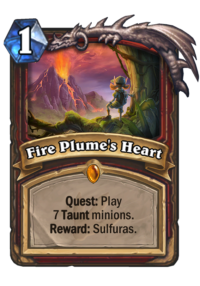
And last, but not least, Fire Plume's Heart. One of the first truly working Quests back in the Journey to Un’Goro, that is going through a renaissance in The Witchwood. Interestingly, though, the Taunt theme in Warrior is much older than the Quest itself. While not many players remember it right now, Taunt Warrior as an epitome of a forced archetype. Blizzard has tried to make it work all the way from TGT, printing many Taunts and Taunt synergies for the class, but it just didn’t work. Un’Goro and Quest Warrior was the first time this theme was finally viable, but funnily enough, all of the synergy cards printed before were simply ignored, focusing on the Quest itself instead.
Quest Warrior is a strong deck mostly because of its reward. 3 mana 4/2 weapon doesn’t sound great, but that weapon changes your Hero Power to the Ragnaros the Firelord‘s effect – dealing 8 damage to a random enemy. And that, as you can imagine, is huge, since you can do it every turn for just 2 mana. While it’s random, you can often isolate the best targets quite easily and then either clear a big minion or deal 8 damage to your opponent – either option sounds good. While you usually don’t want your random effects to hit the opponent in a slow deck, this one is different. After you finish the Quest, you become the beatdown and want to hit as many fireballs to the face as you can – assuming your opponent won’t heal, 3 of them are often enough to kill him (especially if you add two weapon hits).
Despite the deck’s initial popularity, it has disappeared quite quickly due to the meta changes. After 2 or 3 months, it was no longer popular on the ladder, and it was a very unpopular off-meta deck in Knights of the Frozen Throne and Kobolds & Catacombs. Most of players didn’t think about it, when it suddenly came back in The Witchwood – in two versions! During the first few days of this expansion, Odd Quest Warrior (featuring Baku the Mooneater) was a very popular build. However, it quickly turned out that sacrificing so many cards was just not worth it in this case, especially since that upgraded Hero Power didn’t last forever – since you wanted to change it to the 8 damage one anyway. And so, Quest Warrior turned out to be an okay deck. However, it took the nerf patch for people to really realize the deck’s potential. Right now, it’s one of the strongest archetypes in the meta, and a very common sight on the tournaments.
While the older lists tended to curve out higher, running some bigger Taunts, the new lists are mostly small Taunts, survival and cycle. They want to finish the game as quickly as they can. Small Taunts & survival cards are enough to win vs Aggro anyway (big Taunts are often bad, actually, since they come too late), and against slower decks you don’t need big threats if you can change your Hero Power quickly. Phantom Militia was a huge new addition to the deck. You can get 2 or 3 triggers with this card alone, which means that you can run less Taunts overall and still consistently finish the Quest by the late game.
Of course, it’s hard to say whether the Quest will still be viable in the upcoming expansion – after all, it already didn’t survive one meta change, one that happened mid-expansion. But right now, it’s the best Quest deck in the meta, and one of the strongest Quest decks overall.
The Future of Quest Cards
As you can see, Quest cards had a very mixed performance. Some of them were good enough to become the meta decks (Fire Plume's Heart), some of them were so oppressive that they needed TWO nerfs (The Caverns Below), some of them were okay cards with some viable, but not impressive builds around them (Jungle Giants) and some just didn’t work (Lakkari Sacrifice). When I rated Quest cards all the way back in Un’Goro, I didn’t really like them. Most of them were weak and just didn’t work. But looking at them from the perspective of three more expansions, I have to say that I was wrong about it. Some of them just needed a meta change, or some more support. Overall, 5 out of 9 Quests have worked, which is a solid score in the end, given that it was the first time Blizzard has experimented with that kind of mechanic.
However, there is still time for the other four Quests to start working. They won’t rotate out until the first expansion of 2019, which means that we still have two whole sets with Quests in Standard ahead of us. That’s a lot of time to give some decks enough support. For example, another great buff or some buff synergies might make Quest Paladin finally viable. To be honest, they might even make Murloc Shaman viable if they decide to push it heavily. There’s still some untapped potential in those Quests.
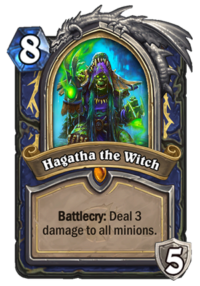
And what about new Quest cards? While I don’t think that Blizzard has shared their plans to print more, I imagine that it will happen at one point. We most likely won’t have Quests as the central point of an expansion, like it was with Un’Goro, but dropping a Quest or two here and there is not out of question. As we’ve already seen, Blizzard is willing to utilize the old mechanics/card types and add some of them into the new expansions. We just had Hagatha the Witch printed for Shaman, and it’s a really cool card that sees quite a lot of play in the class.
Do I like the Quest mechanic? Yes, and no. While I dig the idea or doing some tasks in order to get reward during the match itself, most of the current Quests are pretty boring. They are build around cards, but not a very interesting kind. They force you into a single, narrow kind of build, which works only depending on what cards Blizzard decides to print. I think that Jungle Giants is my favorite Quest, since it gave you more freedom when it comes to deck building, and it had many different uses – I’ve seen four different decks built around it already. That’s why my only hope is that if Blizzard decides to print more, the requirements should be slightly more flexible. At the same time, Quests that are streamlined are much easier to balance – if the Quest forces you to play Taunts, Blizzard can test Taunt Warrior. If the Quest forces you to play e.g. Odd Minions (just an example), there would be so many ways to build the deck that it would be impossible to test every single one of those – players can really come up with some weird creations that devs have never anticipated.
And that’s all folks. I hope that you’ve liked this article. If you have any questions or suggestions, be sure to leave a comment below. Good luck on the ladder and until next time!

I’m hoping for a good odd-costed control tool in Warlock. I had the (mis)fortune of opening a Lakkari Sacrifice, and it’s obviously the worst Quest of all, despite getting a few legendaries and lots of “syngergy” cards. The main problem is obviously that the discard mechanic is too inconsistent in Hearthstone, and the reward of the Quest is aimed at Control Warlocks, not Tempo Warlocks (the discard mechanic is attached to Tempo in Hearthstone, look at Doomguard, Soulfire…). But I was thinking on an Odd Warlock with the Quest, going the Control route… the upgraded Hero Power is great for Control, since you don’t lose health while drawing your answers. The problem is, most of Warlock’s AOE is even-costed right now: Defile, Hellfire and Twisting Nether. We only have Lord Godfrey, and that’s just one card because it’s legendary. We also obviously lose Gul’Dan, although why not run Jaraxxus in that deck? I’m hoping that they print a card like 3 mana: discard your highest Attack minion, deal its damage to all enemy minions. A Shadowflame with discard synergy. It would make this Odd Quest Control Warlock somehow viable.
The problem with the quests is that you had to build a deck around it. If they made a quests that worked with, needing a couple minor changes at most, with existing decktypes you might get some really cool decks. If Murloc Shaman in general had been an ok deck then the quest would’ve made it an extremely cool deck. Even though it would still have the issue that when you play aggro you want to play a friggin murloc in your first turn not activate your quest.
Most quests were either to much of a drag to complete (Warlock), or their rewards weren’t satisfying enough (Paladin).
“I think that Jungle Giants is my favorite Quest” … it’s the only one that’s actually fun: https://twitter.com/ComethTheNight/status/1003722606443401218
I think the biggest reason we won’t see Quests again, is they were *too* mandatory. What I mean is, if you are a free to play player and you see your favorite streamer playing a new deck, but you don’t have a certain legendary they are playing, you can usually swap it out for something else. And yes, you deck will probably be considerably worse, maybe even catastrophically so, but it will still be *playable*. Quests don’t allow this – you either have them or you don’t. If you don’t they can’t be swapped out – the deck is completely broken without them. And this is why I think Team 5 will swerve making any more.
You might have a point there – the only other card I can think of that was mandatory for a deck theme was C’Thun… and Blizzard gave that to everyone.
I don’t think Blizzard will venture into new quests, at least not whitout a heavy meakup on their mechanichs. Most quest decks were either broken or trash, because you have to build your entire deck around the quest, so the reward must be absolutely insane to justify it (quest rogue). Taunt warrior and exodia mage are/were playable, but a LOT of people complain a LOT against them. And quests that gave you a nice but not broken reward were totally ignored (paladin, shaman). Can Blizzard really create new quests that provide an “ok” reaward and are playable?
I hope that quest mage return, even without be a OTK :v
Playing against Quest Rogue was so disguting during Ungoro. At launch time, I just returned to the game after a few months and this deck has beaten the fun out of me. I couldn’t build ladder decks and the matchup was prettxy much ‘wait until you die’. It became a real meme on youtube.
Don’t get me wrong, I love the idea of the quest but to play against it was like freeze mage where you opponent said: ‘You want to play Hearthstone? FUK YOU’ ever time.
Some time later I crafted myself the Warriorquest and was pretty happy with it. I was able to optain most of the cards for the deck. The playstyle was cool too. You had like a first phase where you played safely and spammed taunts and the second phase where you went ‘aggro’.
Although the quests where pretty good in my opinion, the hero cards from KoftFT where much better designed. Also the hype for the expansion and the hero cards was really big with the amazing trailer.
Love your articles Stonekeep. Great Work!